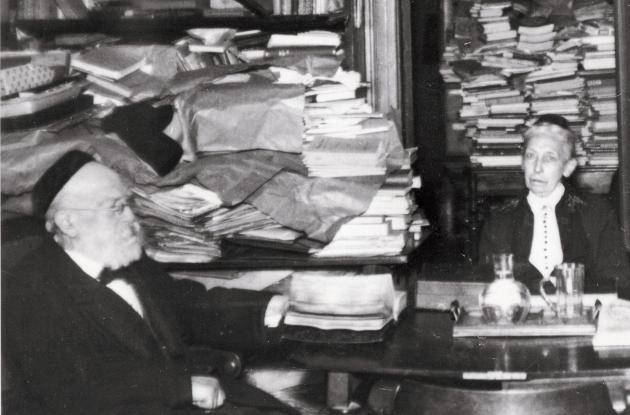David Simonsen's collection of books and manuscripts
A large part of the library's collection of Jewish manuscripts and books originates from the collection of the Copenhagen chief rabbi David Simonsen. Learn more about the background of the collection.

Photo: Det Kgl. Bibliotek
Chief rabbi and professor David Simonsen (1853-1932), whose book collection and archive were acquired by Royal Danish Library in 1932, was a central figure in the Copenhagen Jewish environment for more than sixty years. David Simonsen was born in Copenhagen, and after matriculation he studied Oriental studies at the University of Copenhagen, after which, in 1874, he began his rabbinical training at the Jüdisch-Theologisches Seminar in Breslau. After his graduation in 1879, he chose to return to Denmark, where he was appointed rabbi in the Mosaic Faith Community. The same year he also married Cora (née Salomon, 1856-1938); the marriage was childless. For a period (1892-1902), he also functioned as chief rabbi of the Mosaic Faith Community, while he continued to work on his own research and other interests. In 1903 he became a titular professor at the University of Copenhagen.
Digitised materials
We have digitised much of the David Simonsen collection.
Throughout his life, Rabbi David Simonsen (1853-1932) collected books and manuscripts with significance for Jewish culture and history, but also for his work as a rabbi and researcher.
David Simonsen's correspondence reflects his life and work, especially his work as a philanthropist and mediator of financial and practical assistance in connection with the First World War. About 2/3 of the collection's letters and documents are available digitally.
Read more about David Simonsen and the collection
Through David Simonsen's contacts with the research community, especially through continued contacts with the Breslau Seminary and its teachers and students, and in his own studies, David Simonsen's archive reflects the history of a wide range of sciences over more than fifty years. David Simonsen's broad research interests are reflected in his book collection, of which approx. 45,000 volumes were acquired by the Royal Danish Library shortly before his death, and in his correspondence with the leading scientific circles of the time.
Another area in which David Simonsen was intensely active for many years was aid work, both in Denmark and outside the country's borders. In particular, in the collection of letters - as well as in the rest of the archive - there are many traces of various committees and associations whose purpose was to collect money or other help for those in need. As is clear from the correspondence, Simonsen also acted as a liaison between various forms of aid work.
His collection of books on Jewish subjects, with its approx. 25,000 printed volumes - in Hebrew, Yiddish and Western languages - were complemented by a collection of periodicals, comprising approx. 500 titles. Some titles are only available in a few copies worldwide - the fact that the collection was not damaged during the Second World War makes it, from a European perspective, a rare phenomenon.
In addition to the printed works, David Simonsen's collections also contained a manuscript collection comprising approx. 200 manuscripts. The works included in this collection cover 15 languages and 20 countries of origin, and are all available in digital facsimile editions (David Simonsen's Manuscripts).
David Simonsen's archive reflects his position, not only in Danish cultural life, but also in the international world of research. His extensive correspondence with rabbinic colleagues shows his broad contact with religious and political developments, and his scholarly correspondence provides a good insight into the scholarly debate within the study of Judaism, Islam and Christianity from the late 1870s until his death in 1932. His extensive philanthropic activity at home and abroad has also left a clear mark in the archive, where the needs of both aid organisations and individual, "ordinary" people have clearly occupied him.
About 2/3 of the collection's letters and documents are available as digital facsimile editions.